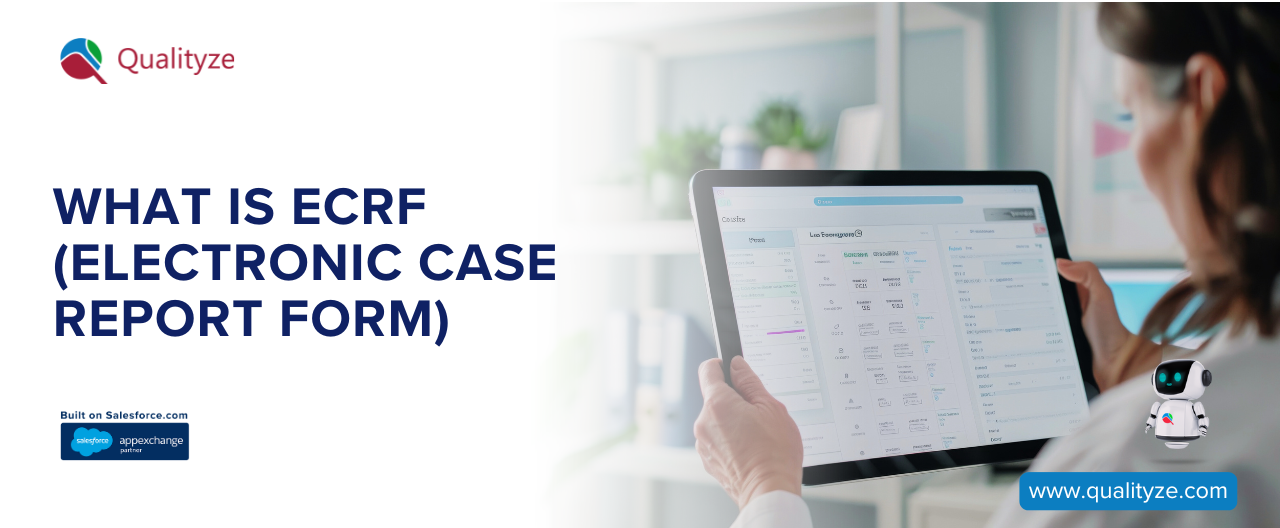Calculate your potential savings with our ROI Calculator
ROI CalculatorCalculate your potential savings with our ROI Calculator
ROI Calculator1 What is the Difference Between Paper CRF and eCRF?
2 Principles of a Good eCRF (Electronic Case Report Form)
3 Key Features of an eCRF (Electronic Case Report Form)
4 Role of Electronic Case Report Form in a Clinical Trial
5 Potential Benefits of Electronic Case Report Form
6 eCRF (Electronic Case Report Form) Completion Guidelines
7 Wrap-Up Summary

eCRF in clinical trials has revolutionized how data is collected, validated, and submitted. This guide explains its features, benefits, and role in regulatory compliance. Learn the difference from paper CRFs, explore best practices, and see how Qualityze ensures success.
Every clinical trial is only as strong as the data it collects. The Electronic Case Report Form (eCRF) has revolutionized how trial data is captured, verified, and reported, enabling faster insights and improved regulatory compliance. An eCRF is an electronic version of the traditional paper Case Report Form (CRF) used to record clinical data in compliance with Good Clinical Practice (GCP) guidelines.
In modern clinical research, eCRFs are integrated into Electronic Data Capture (EDC) systems to allow real-time data entry, validation, and access for multiple stakeholders, including clinical site staff, monitors, data managers, and sponsors. These digital forms are crucial for maintaining data accuracy, traceability, and regulatory alignment throughout the trial lifecycle.
Did you know? Over 80% of Phase III clinical trials now use eCRFs instead of paper CRFs.
Up next, let us go ahead and understand how eCRFs differ from traditional paper CRFs and why this shift matters.
As clinical trials become more complex, the need for reliable, efficient, and scalable data collection tools becomes essential. The difference between paper CRFs and electronic CRFs (eCRFs) reflects the evolution of clinical data management toward smarter digital practices.
Paper CRFs require manual data transcription, prone to errors and delays. eCRFs automate and streamline this process, offering predefined fields, real-time edit checks, and centralized access for better coordination.
| Feature | Paper CRF | eCRF |
| Data Entry | Manual | Digital, real-time |
| Error Rate | High due to transcription | Low, thanks to automated edit checks |
| Compliance | Difficult to audit | Designed for 21 CFR Part 11 compliance |
| Access | Limited to physical location | Remote, secure, multi-user access |
| Cost | High in printing, courier, storage | Lower operational costs over time |
The shift to eCRFs marks a critical improvement in ensuring patient safety and data integrity across multi-site trials.
From the fact files! Paper CRFs can lead to manual data error rates as high as 26%, compared to under 5% for eCRFs.
Now that we've seen the advantages of digital forms, let’s dive into what makes a good eCRF effective in real-world clinical studies.
Designing a high-quality eCRF isn’t just about converting paper to digital. It’s about aligning technology with clinical workflows and regulatory expectations. A good eCRF must be user-friendly, protocol-driven, and validated to ensure that only relevant, high-quality data is collected.
Here are the essential principles:
Did you know? Inefficient eCRF design can increase site queries by up to 35% during trials.
Equipped with these principles, let’s explore the defining features that separate an average eCRF from an exceptional one.
The functionality of an eCRF system can make or break a clinical study’s data quality. Robust eCRF systems come equipped with key features that promote efficiency, accuracy, and collaboration across trial stakeholders.
Top features include:
Next up, let’s understand the critical role an eCRF plays throughout the various phases of a clinical trial.
From start-up study to final submission, the eCRF remains at the core of data capture in clinical research. Its role transcends simple data entry—it underpins operational workflows, ensures GCP compliance, and facilitates transparent sponsor oversight.
Roles of eCRFs in the clinical trial lifecycle:
Trivia! Using eCRFs during on-site visits improves data query turnaround time by 40%.
Having explored its operational role, let’s now uncover the direct and indirect benefits of using eCRFs in clinical trials.
Implementing eCRFs is a strategic investment for any clinical trial sponsor or CRO. Beyond simple digitization, eCRFs unlock tangible and measurable advantages in every aspect of clinical data operations.
Major benefits include:
Let’s now review the best-practice guidelines to ensure your eCRF data remains audit-ready and submission-worthy.
Accurate and timely completion of eCRF is critical for maintaining data quality and regulatory adherence. All stakeholders involved in clinical trials must follow standard operating procedures (SOPs) tailored to their studies.
Here are essential completion guidelines:
Pro Tip: Trials that enforce strict eCRF completion of SOPs have up to 30% fewer regulatory queries during audits.
With this final technical aspect covered, let’s summarize key insights and introduce how Qualityze fits into the solution.
The eCRF in clinical trials is not just a data collection tool—it’s an essential enabler of high-quality, audit-ready, and efficient studies. With proper design, deployment, and training, eCRFs dramatically reduce submission time, improve patient safety, and support global collaboration.
If you're managing complex trials, relying on manual CRFs may compromise your outcomes.
Key Takeaways from the topic
Why Qualityze?
Qualityze offers robust, compliance-ready solutions tailored to the life sciences industry. Our Forms and Compliance Management Solution integrates seamlessly into your existing clinical trial ecosystem, providing audit trails, data integrity, and full 21 CFR Part 11 support.